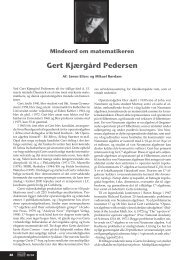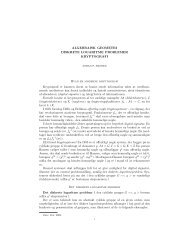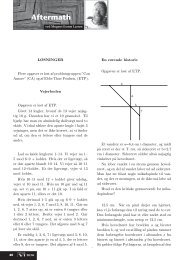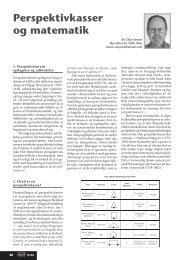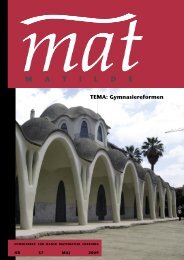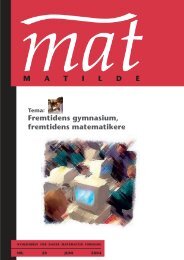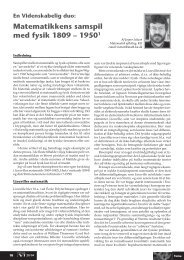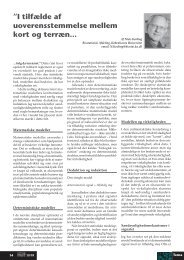TEMA - Matilde - Dansk Matematisk Forening
TEMA - Matilde - Dansk Matematisk Forening
TEMA - Matilde - Dansk Matematisk Forening
Create successful ePaper yourself
Turn your PDF publications into a flip-book with our unique Google optimized e-Paper software.
the ongoing relations between the two institutes and<br />
their respective strengths?<br />
I do not know when the competition started. The Indian<br />
Statistical Institute was founded by Mahalanobis in 1931;<br />
the Tata Institute was founded by Bhabha in 1945. They<br />
were both great friends of Jawaharlal Nehru, the prime<br />
minister at the time, he encouraged them both. Maybe,<br />
there are some rivalries at that level, the institutional<br />
level. The mathematics division of the Indian Statistical<br />
Institute had Dr. C.R. Rao, who was my advisor, as its<br />
scientific director, and the mathematics division of the<br />
Tata Institute was headed by Dr. Chandrasekharan; he was<br />
the moving force behind the mathematics school of Tata<br />
Institute. Maybe, there is some competition there.<br />
I know many of the faculty of the Tata Institute; in fact<br />
many of them were from the same region in the South and<br />
they went to the same university, the same college, perhaps<br />
even to the same high school. So the relationships<br />
between the two faculties have always been friendly.<br />
It is true, the emphasis is very different. At Tata,<br />
they have concentrated on number theory and algebraic<br />
geometry and certain parts of abstract mathematics. The<br />
Indian Statistical Institute on the other hand has concentrated<br />
more on probability and statistics. Although there<br />
has been some overlap, it is really not that much.<br />
We have heard that you still entertain close relations to<br />
India and to Chennai and its Mathematical Institute,<br />
in particular. And in general, you are interested in the<br />
academic development of 3 rd World countries, in particular<br />
through the Third World Academy of Sciences.<br />
Please tell us about your connections and your activities<br />
there?<br />
I go to Chennai maybe once a year now. Earlier it used to<br />
be twice a year, when my parents were alive. I use to go<br />
and spend a month or two in Chennai, and I visit the two<br />
mathematical institutions in Chennai: There is the Chennai<br />
Mathematics Institute, and there is also the Institute<br />
From the interview<br />
of Mathematical Sciences in Chennai. I have visited both<br />
of them at different times; I have close contacts with their<br />
leadership and their faculty.<br />
In earlier times, I visited the Bangalore centre of the<br />
Tata Institute: The Tata Institute in Mumbai has a Centre<br />
for Applicable Mathematics in Bangalore. I spent some<br />
time visiting them, and we have had students from there<br />
coming to the Courant Institute to take their degrees and<br />
so on. To the extent possible, I try to go back and keep in<br />
touch. Nowadays, with e-mail, they can ask me for advice,<br />
and I try to help out as much I can. The next couple of<br />
years, I have some plans to spend part of my sabbatical in<br />
Chennai lecturing at Chennai Mathematics Institute.<br />
You are already the second Abel Prize winner working<br />
at the Courant Institute of Mathematical Sciences in<br />
New York, after Peter Lax. At least in the world of<br />
applied mathematics, the Courant Institute seems to<br />
play a very special role. Could you explain how this<br />
worked out? What makes the Courant Institute to such<br />
a special place?<br />
We are back to the 1930’s, when the Courant Institute<br />
was started. There was no applied mathematics in the<br />
United States. Richard Courant came and he started this<br />
mathematics institute with the emphasis on applied mathematics.<br />
His view of applied mathematics was broad<br />
enough so that it included pure mathematics. I mean,<br />
he did not see the distinction between pure and applied<br />
mathematics. He needed to apply mathematics, and he<br />
developed the tools, he needed to do it. And from that<br />
point of view, I think analysis played an important role.<br />
The Courant Institute has always been very strong in<br />
applied mathematics and analysis. And in the 1960’s,<br />
there was a grant from the Sloan foundation to develop<br />
probability and statistics at the Courant Institute. They<br />
started it, and probability was successful, I think. Statistics<br />
did not quite work out, so we still do not have really<br />
much statistics at the Courant Institute. We have a lot of<br />
probability, analysis, and applied mathematics, and in<br />
33/07<br />
15



